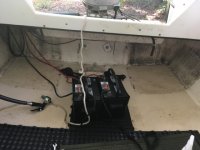So I finally tackled this job today. Hows your new 25 coming Bob, we're dreaming of one after hopefully getting many years out of our 22, lol.
The plan was just to do the port side first as I'd ran the tank almost empty but after getting going I just removed both tanks. There were/are 26 screws through the cockpit sole, 8 for the two battery hold downs, 14 for the forward and midship starboard strips that hold the tanks in place, and 4 at the aft end of each tank that holds the tie down strap.
On the starboard side one of the forward star-board strip screws had an elongated hole through the deck. Look like someone tried to remove the screw and put it back in at an angle so it would bite onto something and tighten. It just made a larger hole for water intrusion. I was able to stick a screw driver down in there and move it a good inch or so forward and aft and felt no balsa. So tomorrow I'm going to overdrill the hole and poke around in there to see what I can find, then eventually use either penetrating epoxy or thinned epoxy to fill it.
Now I have to find the best way to go back with these. Tentatively the plan is to overdrill all of the holes and fill with thickened epoxy, then use the wood screws (best screw choice?) and some sealant adhesive (3m 4200?) for the star-board strips that border the tank. For the metal strap that holds the aft tie down I'm thinking of eliminating those screws through the deck and glassing a block down to the cockpit, or just up on the transom to screw into. In "This Old Boat" by Casey he recommends laying some cloth over and under the block, other wise he says it will eventually pop off, any thoughts on this versus just sitting the block in thickened epoxy?
For the battery hold down I'll also glass some block down to screw those into. That will eliminate 12 screws.
I've considered glassing down the star-board strip that sit toward the centerline and are oriented for and aft so I could eliminate those screws but if I laid cloth over them it would create a little lip around the edge of the bottom of the tank and I don't want to do that. I've also considered just eliminating that forward partition and just strapping the tank down to the forward starboard strip as seen in that 90's C-Dory 22 on the for sale page. Lots of decisions to make in the morning, plus I need to take a hair dryer to the holes and make sure it's dry in there. I prob got a little water intrusion while I was cleaning the area.
I've also thought about putting a thin piece of rubber or neoprene under the tanks for cushion but I don't have a lot of clearance above the tank. I need to find some store where I can get something like that, any ideas?
I also decided to replace all of my fuel lines from the tanks to the filter, and I need to find a new decal for my fuel tank selector as the old one is faded but the lines were hooked up wrong anyway. Port drew from the starboard tank and vice versa. Sorry for the rambling, just thinking out loud.
Last thing, I was surprised to find 25gal tanks, the owners manual says 20 gal tanks.
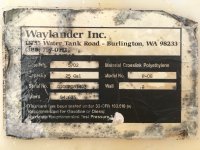
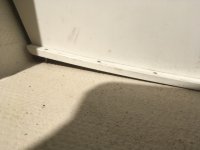
One tank removed
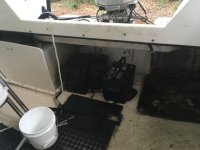
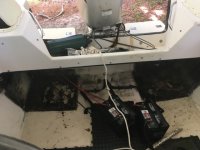
Cleaning up the tanks
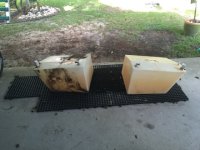
Just about ready for the install
